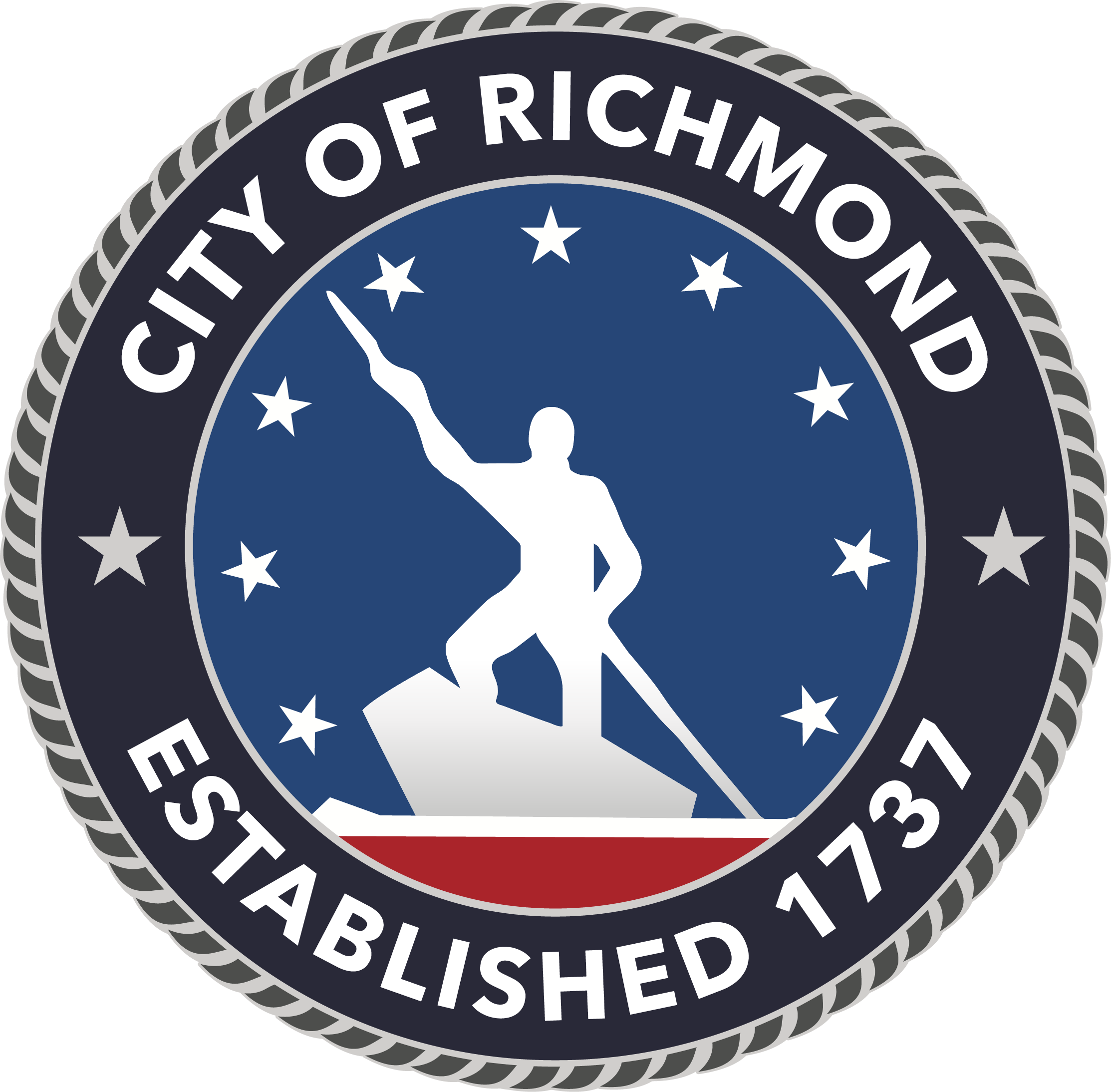Walk-in: 900 E. Broad St., Room 600, Richmond, VA, 23219
Phone: 804-646-0436
Fax: 804-646-6415
Email: R[email protected]
Address:
900 E. Broad Street
Richmond, VA
23219 USA
Hours: Mon - Fri (8 a.m. - 5 p.m.)
Phone No. 804-646-6430
Email: Ask Public Works
Right-of-Way Management
The Right of Way Management Division provides reviewing, permitting and coordinating for all activities in the right of way in order to ensure public safety and mobility.
Objectives:
- To ensure through the proper management of programs and resources along with the coordination of internal City departments to enhance the health, safety and welfare of the residents, businesses and visitors of the City of Richmond;
- To ensure that all construction performed within the City right of way adheres to all local, state, and federal regulations;
- To ensure that all permitted activity within the public right of way provides for safe and efficient movement of all road users (vehicles, pedestrians, and bicyclists) through or around temporary traffic control zones while protecting the public, workers, incident responders, public infrastructure and equipment;
- To ensure that all permitted construction improvements (by private and public forces) within the public right of way are constructed to appropriate and accepted standards and requirements that they may be accepted into the City's infrastructure
All work performed within the public right of way requires a Work in Streets Permit. Application for such permits is made at City Hall in Room 110 or Digitally via email to [email protected]. See below headings for additional information on process and requirements. Click here to check for all status updates for you application.
Types of work that require a Work in Streets Permit include (but are not limited to): Excavation, Construction Staging, Dumpsters, Portable Storage Units (PODs), Cranes, Boom Lifts, Man Lifts, New Subdivision Construction, Driveways, Carriage Walks, Sanitary Sewer Laterals (other Utility Work), Temporary Structures
Requirements
- Right of Way Work Zone Policy
- Ordinance 2019-314
- Completed Application Click Here for Application
- Site Plan
- Traffic Control/Maintenance of Traffic (MOT) Plan
- If a contractor is making the application they must provide:
- Certificate of insurance. See example.
- Contractor’s license information.
- Fee for the appropriate permit. Click here for schedule. Fees may be paid by personal check or by credit card. Payments can be made online. Users must first register per the Online Payment Guidelines. Upon receipt and entry of permit application, user will then be invoiced accordingly and will be able to pay the invoice online once they have become a Registered User
* Electronic Submittal Accepted at [email protected]
In accordance with the current Fee Schedule (Click for Fee Schedule), fees are charged for any work in the right-of-way.
The fee is due when a customer submits a Work in Street Permit application. The fee is based on the project or work and the duration of the project or work. The fee must be paid prior to permit issuance.
Please contact Right-of-Way Management for any questions.
Please note that the Work in Street Permit fee is due when submitting the application, and can be paid for at the Room 110 at City Hall
Room 110
900 East Broad St
Richmond, VA 23219
All fees for Work in Street Permits are due prior to permit issuance. Please note that metered parking fees associated with the work will be charged separately through DPW Parking Services. More information can be found on this page.
A sidewalk may be obstructed temporarily for the contractor to perform work. Contractors must create temporary protected pedestrian pathways and bikeways if construction impedes a pedestrian pathway/bikeway. The pedestrian pathway/sidewalk shall remain accessible if possible. Any obstruction in the sidewalk must be approved prior to the setup of the work area. Required documentation for permit request with sidewalk obstruction and pedestrian detour:
- Right of Way Work Zone Policy
- Ordinance 2019-314
- Pedestrian Routing Plan must meet standards of the Americans with Disabilities Act, Public Right-of-Way Accessibility Guidelines,Manual on Uniform Traffic Control Devices, Virginia Work Area Protection Manual
Depending on the type of work that encompasses the sidewalk obstruction, additional plans and permits may be needed.
A lane obstruction involves the occupation of a lane or lanes during a project but not closing the street off completely. This can be in the form of a flagging operation, or other traffic shifts to allow continuous vehicular movement. This does include shoulder work, as equipment may need to be moved on and off the road.
Required documentation for permit request with full and partial lane obstructions:
- Right of Way Work Zone Policy
- Ordinance 2019-314
- Engineered/Detail Plans for construction; and,
- Maintenance of Traffic Plan (MOT) (must meet standards of the Americans with Disabilities Act, Public Right-of-Way Accessibility Guidelines, Manual on Uniform Traffic Control Devices, Virginia Work Area Protection Manual;,
Depending on the type of work that encompasses the lane obstruction, additional plans and permits may need to be approved.
A full street closure is designed to eliminate the exposure of motorists and bicyclists to work zones, while providing a safe working environment for workers by temporarily closing a street for construction and/or maintenance. During a full street closure, traffic is typically detoured, allowing workers full access to roadway facilities and ensuring that motorists and Bicyclists are rerouted properly to their destinations around the work area.
Required Documentation for permit request with full street closures:
- Right of Way Work Zone Policy
- Ordinance 2019-314
- Maintenance of Traffic Plan (MOT) and Vehicular Detour Plan, and Pedestrian Plan in accordance with standards of the Americans with Disabilities Act, Public Right-of-Way Accessibility Guidelines, Manual on Uniform Traffic Control Devices, and Virginia Work Area Protection Manual; and,
- Memorandum outlining the proposed work and logistics.
- Certified traffic technician or engineer may be required for Maintenance of Traffic Plans
Depending on the type and nature of the work that requires the full street closure, special conditions may need to be imposed upon the approved permit.
Any Street/Lane Closure that will result in a loss of metered parking space(s) will require a parking permit from the Parking Division (Room 102 City Hall) in conjunction with the requirements for a Work in Street Permit.
Any person may apply for a permit by submitting a completed application form prescribed by the director. Parking permit applicants shall pay a fee equal to Fifty (50) percent of the daily meter charge for each parking space included in the permit multiplied by the number of days for which the permit is sought. The parking permit will authorize such person to place a cover on or over a meter and to use a parking space regulated by that meter. A Parking permit may include multiple meters and parking spaces. A parking permit provides no property interest in any parking space or any other part of the right-of-way.
Required documentation for permit request occupying use of metered parking spaces:
• Number of metered parking spaces used
• Length of time metered parking will be out of service
Depending on the type of work that requires the parking area; additional plans and permits may need to be approved.
Any Major or Minor Utility Cut made in a local, collector, or arterial road in the City will require a Work in Street Permit.
Required documentation for permit request with major and/or minor utility construction and street cuts:
- Plans showing the installation path of the electrical, telecom, sewer, water, or gas lines
- Maintenance of Traffic Plan (MOT) (must meet standards of the Americans with Disabilities Act, Public Right-of-Way Accessibility Guidelines, Manual on Uniform Traffic Control Devices, Virginia Work Area Protection Manual;
- Per City Ordinance 2019-314 Any contractor that performs an excavation or causes an excavation to be performed in the public right-of-way shall, within at least three calendar days after the excavation is complete as determined by the Director of Public Works, maintain, repair or reconstruct the site of the excavation as necessary to maintain a condition satisfactory to the Director until such time as the City reconstructs, repaves or resurfaces the public right-of-way
Nothing contained in this section shall be construed to prevent any person from performing an emergency excavation for the preservation of life or property so long as such person ensures compliance with the following requirements:
(a) Before the emergency excavation is initiated, the owner shall notify the
Department of Public Works Right of Way Division. The owner shall also notify all other federal, state or local authority required by applicable law.
(b) Within 24 hours after the initiation of the emergency excavation, or within 24 hours after the Department’s offices first open following the initiation of the emergency excavation, the owner shall apply for a permit for the emergency excavation.
The requirements above shall not apply to Federal, State or local governmental entities performing excavation work with their own forces but shall apply to all contractors or other persons that perform the excavation work on behalf of such Federal, State or local governmental entities.
Private development projects can range from a facade alteration to a high-rise project in downtown, to new buildings and infrastructure installation throughout the city.
A traffic control plan and pedestrian plan must be submitted, reviewed, and approved prior to the start of work that affects the right-of-way. Private development plans may require items found in the DPW Checklist.
Prior to any plan submittal, it is recommended that a meeting be set up with the Right-of-Way Manager to discuss the projects traffic control and pedestrian routing.
Traffic control plans (Maintenance of Traffic (MOT Plans) and pedestrian plans must also comply with DPW Administrative Directive Work Zone Policy
Required documentation for permit request that are for private development projects:
- Approved DEVR plan signed by Right of Way Management
- PODs/SUPs and Subdivision Plans are only conceptual plan. Construction Site Plans are required to be submitted to DPW and DPU upon approval of such plans prior to issurance of permits.
- PODs/SUPs and Subdivision plans should be designed per City of Richmond Better Streets Manual guidelines and requirements of the Department of Public Works Right of Way and Excavation Manual
- Streets/Roads should be designed according to VDOT Urban Manual guidelines. Design should follow ASTM guidelines per engineering best practices
Pre-Construction Meeting Scheduling:
• A pre-construction meeting with the Right of Way Inspector is required 5 (five) business days prior to the start of any work or obstruction of the right-of-way. This includes but not limited to:
- Demolition, mass grading, and sidewalk removal;
- Utility installation (Water and Sewer);
- Any lane or sidewalk closures
- Permits are required prior to ANY work or obstructions in the right-of-way. The City may require customers to schedule a meeting prior to permit issuance.
• Contact Information for the Right of Way Inspector may be found on the Work in Street Permit
Mobile Portable Storage Containers
Attached is the application to work-in-streets-and-alley that must be filled out to obtain a permit to close any portion of the City’s right-of-way to place a POD/Storage Container. The application must include the following:
- Applicant Name with contact number
- Property owner information
- Contractor information with state license number, class, and classification
- ( Place information from the POD/Storage Container company here )
- Proposed work or site location
- Brief description of work
- ( “Barricade curb lane/parking lane of ___ Street to place a POD/Storage Container for …” )
- Approximate length of work with start and end dates
- ( If known )
- WISP class and type with estimated cost of work
- ( Within the public right-of-way )
Along with the application, a sketch or plan clearly showing the proposed location for the POD/Storage Container, labeling the street, sidewalk, and any other existing features near the location. Provide a distance to the nearest intersection or other fixed object ( tree, power pole, hydrant, etc… ).
Note: The application, attached sketch, insurance and payment form can be emailed to [email protected], approved and then then emailed back to you.
Forms
- WISP Application ( Printed version )
- WISP Application ( Fillable version)
- Restricted Area for Dumpsters and PODS/Storage Containers Layout
- Credit Card Payment Form
Parklets are small platforms that take the place of two or more on-street parking spaces. The offer amenities that allow people to stop, sit, and enjoy their neighborhood street life. Parklets act like a community front porch or stoop. For more information, click the below links.
Purpose
It is strongly suggested that construction site plans for all work in the City right of way undergo a development review plan (DEVR), unless otherwise stated, prior to applying for a Work In Street Permit from the Right of Way Division. This will ensure that all agencies have reviewed and approved the construction site plan to be used for construction.
Pre Application Meetings
The City of Richmond encourages developers to schedule a development plan review meeting with the Right of Way Division prior to submission of a development review plan. During this meeting, staff will review the proposal and discuss potential construction considerations such as drainage impacts, public utilities, landscaping, lighting, traffic, and other site development requirements.
Development Plan Review
- Applicant must ensure all items have been completed on the DPW Checklist
- Plans, DPW checklist, and other supporting documents are to be submitted to [email protected] email.
- Staff circulates the plans to applicable City agencies for review.
- Staff will compile the review comments and provide them to the Applicant.
- Re-submissions or revised plans may be submitted at any time after receipt of comments.
- After approval, the applicant can apply for any necessary permits.
- Approved plans will receive a DPW Stamp of Approval.
Surveys provides field and office surveying support for many projects involving the City’s r/w and properties which include support for Capital Project Management, Traffic Engineering, Urban Forestry,Planning and Development Review, Economic and Community Development and City Attorney’s Office.Surveys is also continuously providing maintenance and gathering additional data and documentation of right-of-way monumentation. Surveying activities are performed according to standards set by the Commonwealth of Virginia Department of Professional and Occupational Regulation.
A baseline map is a record map showing a network of reference baselines that are used as a foundation for measuring or comparing current and past city right of way. The base line consists of angles and distances for measurements used for point of reference of the city right-of way boundary.The baseline also references right of way changes noted by (DPW) project numbers along with the ordinance or regulation review and construction. The baseline is updated accordingly with associated right of way changes.
The scanning procedures and methodologies to be implemented in-house is referred to as the Record Management and Maintenance System, of which the “Image Archived/Document Management System” is a GIS-enabled application to be used for a) managing scanned image .pdf or .tif files, b)managing metadata about image files in a geodatabase, c) querying, viewing, and printing DPW (Department of Public Works) site/plan drawings.
At times, citizens or City agencies will request that a public right-of-way (i.e.: improved or unimproved streets and alleys) be closed/vacated (i.e. extinguish the right-of-way). Right-of-way can only be closed by a duly enacted ordinance of the City Council (ref. City Code Section 90-326).
To initiate the closing process the applicant submits a letter of request, application fee and certified plat of the area to be closed to the Director of Public Works. Surveys will review and solicit comments from various City Agencies and will be in contact with applicant to obtain additional information and to address any issues which may arise. A document containing Right-of-Way Closing Guidelines describes the process in more detail and provides additional information concerning the procedure.
If the review process yields positive results an Ordinance & Resolution paper will be prepared to request that an ordinance be introduced
Guidelines for Closing (Vacation) of City's Public Right-of-Way
The naming or renaming of the City’s public right-of-way requires a duly enacted ordinance of the City Council (when not thru subdivision process). A request for this can be initiated by submitting a letter to the Director of Public Works denoting the actual request, the purpose or reason(s) for the request, a brief explanation of why the proposed name is being requested and a plat or sketch delineating the limits of the r/w to be named.
Other requirements (including approval of the name by the Richmond Regional Planning District and notification or consent requirements with affected property owners) and further details of the Right- of-way naming/renaming process can be found in a “working document” titled Changing the Name of Public Right-of-Way.If the review process yields positive results an Ordinance & Resolution paper will be prepared to request that an ordinance be introduced.
Policy for the Naming/Renaming of City's Public Right-of-Way
Items located within the City’s public right-of-way and not owned by the City are considered to be encroaching and must have some form of authorization from the City. Most permanent encroachments can be authorized thru the Administrative Encroachment Process. An Encroachment Permit Application is submitted at Room 110 of City Hall along with an application fee and plat or sketch which clearly dimensions the size of the encroachment and its exact location within the right-of-way. Further details about encroachments (including reviews by UDC or CAR and compliance with Building Code) and the application process can be found in a “working document” titled Procedure Outline for Initiating an Encroachment Approval Process in the Public Right-of-Way.
If an encroachment cannot be approved administratively it can be considered for approval by the City Council. The request and procedure is much the same as that used for r/w closings and naming/renaming.
The City of Richmond 1999 Geodetic Network conforms to Federal Geodetic Control Committee firstorder accuracy standards for global positioning system horizontal networks. There are 53 geodetic ground control stations/monuments with survey mark reference and recovery data. If any monument is found to have been disturbed or destroyed, please contact the Surveys Division (804)646-0436 of the Department of Public Works.
• Date Created: April, 1999
• Vertical Data: North American Vertical Datum of 1988 (NAVD88)
(note: the most of elevations are GPS derived)
• Horizontal Data: Virginia Coordinate System, South Zone (4502) NAD83 VA HARN• GIS Data: Geodetic Ground Control Point
• Geodetic Ground Control Monuments Map
Mission Statement
Records Management is a fully equipped in-house imaging operation, designed to convert paper to electronic images by offering a variety of records management services, and provide a sound records management program to ensure the department retains the necessary information to meet legal, administrative, research, planning and historical needs for the orderly gathering and processing of the City’s Right of Way information in the most cost-effective manner. A GIS-enabled application to be used for, a) managing scanned image .pdf or .tif files, b) managing metadata about image files in a geodatabase, c) querying, viewing, and printing.
Document Recording & Imaging
Record management solution is a fully equipped in-house recording and imaging operation. It is comprised of managing metadata about the city’s right-of-way related projects, and managing their scanned image file associated with individual project by hyper-linking throughout a GIS-based record management system. This solution provide spatial reference of project drawing boundaries, stand-alone tabular attribute table, all associated metadata and reference links to the scanned drawing images within the Enterprise Geodatabase.
Document Storage
Record Management allows to store site/plan, archived and subdivision plat drawings/documents into a centralized storage solution to assist departmental staff managing tasks involved with finalized drawings and documents of the City’s right of way related issues. The central storage solution provides with geographical and attribute information associated with electronic image files which are hyperlinked to scanned imagery files in .pdf or .tif file format.
Document Retrieval
Record Management provides the service of locating of records/documents, printing their information and delivering them in soft copy format. This solution allows to access to querying, viewing, printing of metadata associated with the scanned image files on a GIS-enabled application.
Dissemination of Records/Documents & Drawings/Maps
Record management provides the service of printing drawings & maps, mapping on the City data on GIS, delivering in soft copy format in .pdf or .tif file via Email or CD. The following information can be provided in soft/hard copy format at the customer counter top desk located Room 600, City Hall.
- Site/plan drawings
- Subdivision Plat drawings
- Baseline maps
- GIS Base maps
- FEMA FIRMs (Flood Insurance Rate Maps)
- Contour maps
BETTER STREETS MANUAL
Part 1: Better Streets Manual
Part 2: Right-of-Way Design and Construction Standards Manual
Part 3: *Right-of-Way Excavation & Restoration Manual
*The City of Richmond provides the Right-of-Way Excavation & Restoration Manual in downloadable
format so that developers can easily refer to city requirements for working in the right-of-way.
Updates are made regularly, so please revisit this section in the future to ensure you have the
latest version of this important document.
Development Review Plan (DEVR)
Request Forms of GIS Base Maps & Baseline Drawings
City’s Public Right-of-Way Closing, Naming/Renaming Policy & Guidelines
Encroachment Processing
- Encroachment Permit Application
- Procedure Outline for Initiating an Encroachment Approval Process in the Public Right-of-Way







